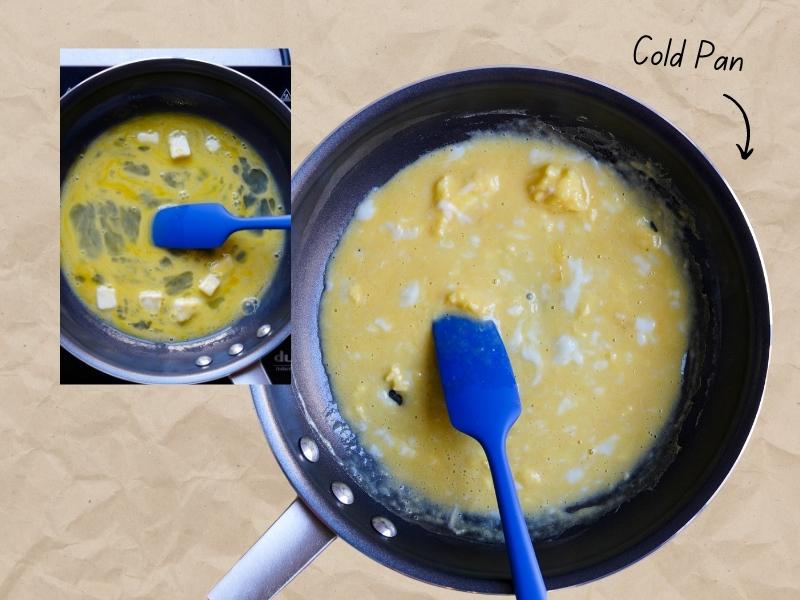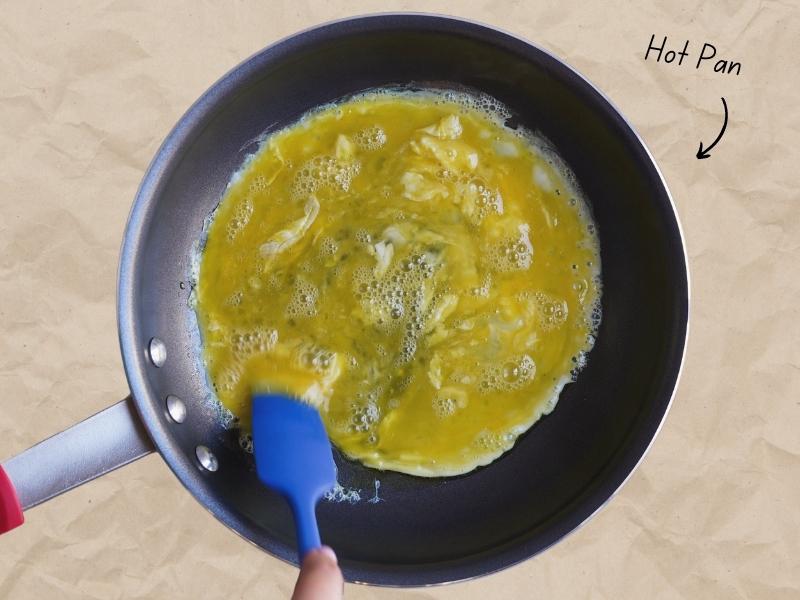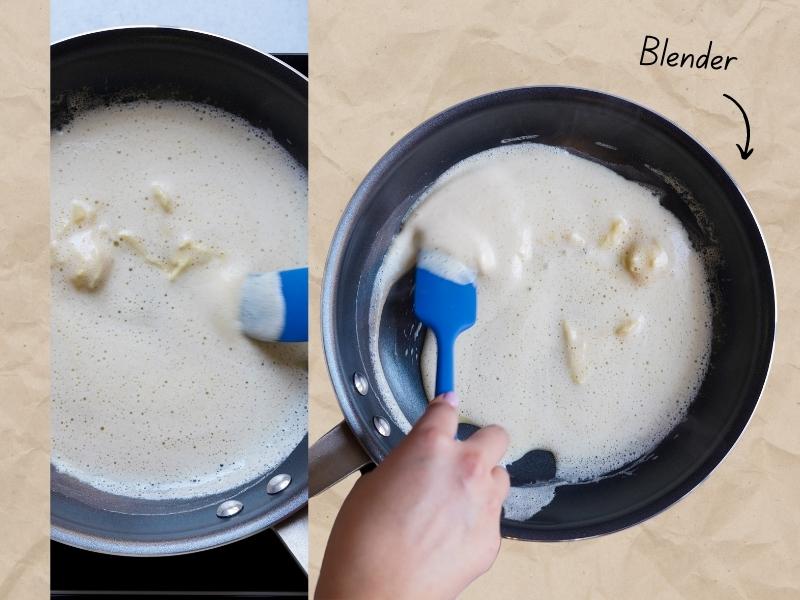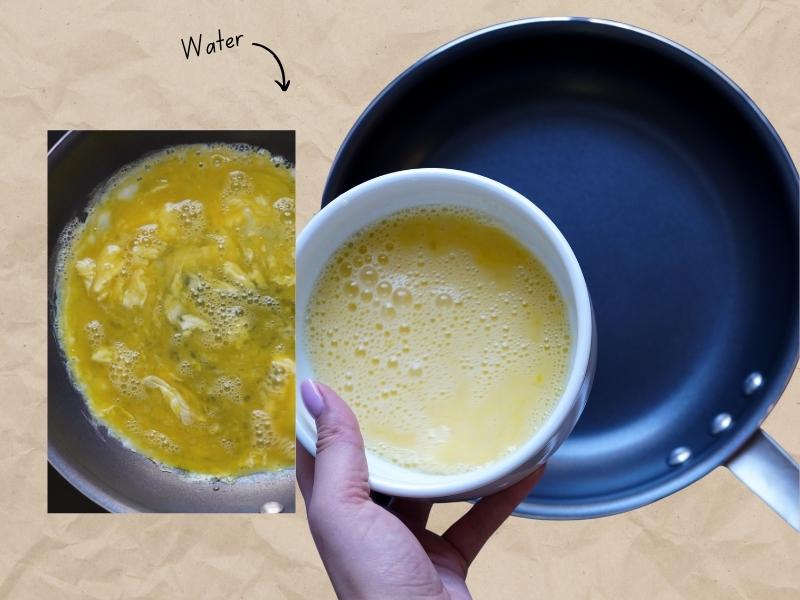The topic of eggs is not something I take lightly. During culinary school, we dedicated an entire week (read: 20 hours in the kitchen) to learning all the different methods to prepare eggs…boiled, omelets, soufflés, you name it. But I’ll be the first to admit that of the dozens of techniques we learned, I apply only one every day: scrambling eggs. This is what sparked my motivation to test six ways to make the fluffiest scrambled eggs ever. And folks, we have egg-ceptional news, which is that there’s *actually* one clear winner.
A few things to keep in mind about this scrambled eggs experiment
First things first, I want to define the control variables in the experiment. For each trial, I used two organic pasture-raised eggs left out of the fridge for about an hour before cooking to come to room temperature-ish. Next, I used Diamond Crystal Kosher Salt for seasoning, and if butter was used, it was unsalted. Additionally, I used unsweetened Elmhurst 1925 Cashew Milk when milk was required and Graza Drizzle Extra Virgin Olive Oil to grease the pan if needed. Lastly, my go-to nonstick pan of choice was the 10-inch Tramontina Professional Aluminum Nonstick Restaurant Fry Pan (which retails for $33 on Amazon).
Now the fun part: the variables. To figure out the best way to scramble eggs, I narrowed it down to six of the most popular techniques I’ve encountered over the years. This included the following methods: cold pan, hot pan, microwave, blender, water, and bain-marie. For each of these, I assessed them based on the final “fluff” level (or consistency) and how long it took me to prepare them (in minutes). For their fluffiness, I ranked them on a one to five scale—five being the fluffiest.

6 ways to prepare scrambled eggs
1. Cold Pan Method

For this method, I took inspiration from Gordon Ramsay’s scrambled eggs recipe, which has over 50 million views on YouTube. In a nonstick pan, add two eggs (not whisked) and a tablespoon of cold butter. Then, turn the heat to medium, medium-high, and begin whisking the eggs with a heatproof spatula. As curds start to form, alternate between moving the pan on and off the heat while stirring—think of making risotto. Repeat this process about four times, being careful not to overcook the eggs—season with salt about halfway through. Then, just before the eggs are fully cooked, remove them from the stove—the residual heat in the pan will continue to cook them.
Texture: Creamy (not so much fluffy), small curds, and a smooth, luxurious, melt-in-your-mouth feel.
Time: 5:20 minutes
Fluffiness: 2/5
2. Hot Pan Method

Admittedly, this is the method I use on a day-to-day basis when I’m pressed for time. In a small bowl, whisk together two eggs with a pinch of salt. In a nonstick skillet, over medium to medium-low heat, add one teaspoon of olive oil. Once the oil and the pan are moderately hot (about a minute), add the whisked eggs. Using a heatproof spatula, slowly displace the egg mixture by moving from one end to the other to create a scraping effect and form large curds. Remove the eggs from the pan just before they’re fully cooked.
Texture: Soft large curds that should be eaten soon after cooking to avoid rubberiness.
Time: 2:35 minutes
Fluffiness: 3/5
3. Microwave Method

Yes, it’s quick and easy—but the shortcut is noticeable in the final result. In a small, microwave-safe bowl, combine two eggs, a pinch of salt, and two tablespoons of nut milk (should be a one tablespoon per egg ratio) and whisk until combined. Then, microwave on high in 30-second increments, stirring in between to break up the egg curds until fully cooked. Should be two to three times depending on your microwave’s power.
Texture: Very rubbery and inconsistent texture with distinguishable flecks of yolk and whites.
Time: 2:00 minutes
Fluffiness: 1 (or 0)/5
4. Blender Method

This was the most surprising of all the methods in terms of convenience and fluffiness. Blend two eggs and a pinch of salt in a blender until light and foamy. In a nonstick skillet over medium to medium-low heat, add the eggs. Avoid agitating them until the bottom begins to curd to help preserve the air bubbles. Using a heatproof spatula, slowly stir the eggs to form large curd-like pieces and remove them just before they’re done cooking—there will still be some foam on the surface.
Texture: Soft and fluffy large curds with a small amount of egg foam on top.
Time: 2:45 minutes
Fluffiness: 4/5
5. Water Method

This is the method many have been using for quite some time now (thanks, TikTok). In a small bowl, whisk together two eggs, two tablespoons of water (it should be a one tablespoon per egg ratio), and a pinch of salt. In a nonstick skillet over medium to medium-low heat, add the eggs. Using a heatproof spatula, slowly stir the eggs to form large curds.
Texture: Fluffy large curds with an airy texture.
Time: 2:30 minutes
Fluffiness: 5/5
6. Bain-Marie Method

I’ll preface this by saying that it’s definitely an arm workout. In a medium saucepan, add about two inches of water and bring to a boil over high heat. Once boiling, reduce the heat to a simmer. Then, carefully place a heatproof glass bowl over the saucepan, ensuring the bowl’s bottom does not touch the water. Add two whisked eggs, one tablespoon of butter, and a pinch of salt. Using a heatproof spatula, slowly stir the eggs until small curds form.
Texture: Small, smooth, and creamy curds.
Time: 10:25
Fluffiness: 2
The best way to cook scrambled eggs, according to our tests
TL;DR? The results are in. The best way to cook scrambled eggs is hands-down the water method.
Adding a splash of water to your egg mixture has a transformative effect. Of all the methods, this one ranked highest in terms of fluffiness—the egg curds felt airy and light. Of course, you can also test swapping water with milk or heavy cream, too. Coming in at a close second in terms of fluffiness was the blender, followed by the hot pan techniques.
Now, if creaminess and a luxurious mouthfeel are your ultimate goal, the cold pan and bain-marie methods are your best bets. Lastly, the microwave method should only be used as a last resort—as it resulted in highly rubbery scrambled eggs. Ick.
An RD shares why eggs are basically nature’s multivitamin:
Our editors independently select these products. Making a purchase through our links may earn Well+Good a commission.
